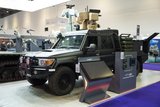Raytheon steps up again for QEWR
Raytheon has obtained another contract modification for work on the Qatar Early Warning Radar (QEWR), bringing the cumulative value of the FMS programme to $1.14 billion.
Work on the latest $13.65 million modification will be performed in Andover, Massachusetts for completion by December 2025, the DoD announced on 8 December.
The Air Force Life Cycle Management Center at Hanscom Air Force Base is the contracting activity.
Raytheon was officially contracted to supply the QEWR in 2017, after an agreement was reached in December 2016. The company subsequently received $36 million and $9 million modifications in August 2019 and June 2020 respectively.
The AN/FPS-132 Block 5 radar (pictured) forms the backbone of QEWR, to provide long-range detection for the national layered Integrated Air and Missile Defense framework which includes Patriot systems and an Air Defense Operation Center for C2.
The system is designed to operate 24 hours a day, 365 days a year, with minimal staffing and maintenance.
As part of our promise to deliver comprehensive coverage to our Defence Insight and Premium News subscribers, our curated defence news content provides the latest industry updates, contract awards and programme milestones
Related Equipment in Defence Insight
More from Digital Battlespace
-
![Babcock nears first customer for Nomad AI translation tool]()
Babcock nears first customer for Nomad AI translation tool
Nomad can provide militaries with real-time intelligence, saving critical time on the battlefield.
-
![AUSA 2025: Israel’s Asio Technologies to supply hundreds of improved Taurus tactical systems]()
AUSA 2025: Israel’s Asio Technologies to supply hundreds of improved Taurus tactical systems
Taurus operates alongside the Israel Defense Forces’ Orion system which supports mission management across tens of thousands of manoeuvring forces, from squad leaders to battalion commanders.
-
![AUSA 2025: Kopin pushes micro-LED plans as China moves faster]()
AUSA 2025: Kopin pushes micro-LED plans as China moves faster
The plan for the new displays follows fresh investment in Kopin’s European facilities by Theon and an order for head-up displays in fielded aircraft, with funding from the US Department of Defense.
-
![AUSA 2025: Persistent Systems to complete its largest order by year’s end]()
AUSA 2025: Persistent Systems to complete its largest order by year’s end
Persistent Systems received its largest ever single order for its MPU5 devices and other systems earlier this month and has already delivered the 50 units to the US Army’s 4th Infantry Division.
-
![Aselsan brings in dozens of companies and systems under the Steel Dome umbrella]()
Aselsan brings in dozens of companies and systems under the Steel Dome umbrella
Turkey has joined the family of countries attempting to establish a multilayered air defence system with government approval in August 2024 for the effort landed by Aselsan. Dubbed Steel Dome, the programme joins Israel’s Iron Dome, the US Golden Dome, India’s Mission Sudarshan Chakra and South Korea’s low-altitude missile defence system.
-
![DSEI 2025: MARSS unveils new agnostic multidomain C4 system]()
DSEI 2025: MARSS unveils new agnostic multidomain C4 system
MARSS’ NiDAR system has been deployed using sensors from static platforms to provide detection and protection for static sights, such as critical infrastructure, ports and military bases.




























